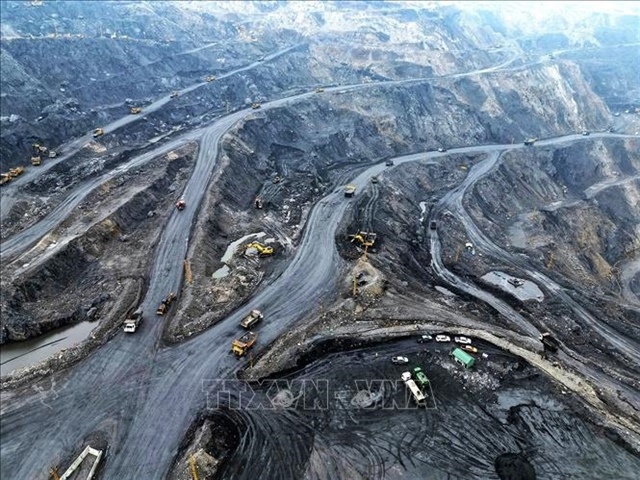Cement industry to form trade groupby Thien Ly
Cement industry to form trade groupby Thien Ly
The Ministry of Construction has sought clearance to set up a clinker and cement exporters association hoping that among other benefits, it would improve co-operation within the industry and ensure there is no undercutting.
Six of eight companies that export cement and clinker are local firms – Vicem, Ha Long, Thang Long, Cam Pha, Vissai, and Cong Thanh. The other two are foreign-invested firms or joint ventures.
In a note to the Government, the ministry said that although the Viet Nam Cement Association recently held a meeting with manufacturers who promised not to undercut rivals to reduce export losses, some had failed to keep their word, creating unhealthy competition and negatively affecting the entire industry.
Cement producers' costs have recently surged following a hike in the prices of coal, electricity and oil by170 per cent, 19 per cent, and 40 per cent respectively.
But with exporters still deciding to cut prices, the export price of Vietnamese cement is 10 per cent lower than other countries in the region.
This is wrong and irrational, not to mention unsustainable.
An official of the Viet Nam Cement Association said many exporters are offering clinker at US$36 per tonne and cement at $50, which are lower than costs. The clinker freight on board price should be at least $40, he reckoned.
A spokesperson for the Fico Tay Ninh Cement Joint Stock Company said there was no profit to be made even at $40 for clinker and $50 for cement.
This unhealthy competition has been attributed to a lack of co-operation among domestic enterprises in production and sale of clinker and cement in both domestic and overseas markets.
In addition to the proposal of setting up a cement clinker exporters' association, many industry experts have also said that the Viet Nam Cement Association should continuously provide updated information about quantity as well as price of clinker and cement products in the world market.
This would help domestic firms make timely adjustments to their production schedule as well as their prices, they said.
Forex rate stabilises
Early this month, the State Bank of Viet Nam affirmed that the exchange rate has been more stable in the last six months with fluctuations kept at between two and three per cent.
The exchange rate stability was achieved because the Government's monetary policies, including strict foreign currency management, were carried out effectively. Thanks to these policies, people's confidence in the local currency has also been strengthened.
Additionally, the foreign currency mobilising and lending relations between enterprises and banks is being gradually replaced with trading, which has contributed to significantly reducing risks and inequality in the foreign currency market.
This can be seen by the fact that the volume of dollars mobilised (as deposits) by credit institutions as of June 30 decreased by 2.2 per cent, while the volume of the greenback bought by them in the same period increased sharply.
When commercial banks bought large amounts of foreign currency and then sold them to the central bank, it helped increase national foreign currency reserves to the equivalent of 10 weeks of imports.
A senior economist has predicted that the foreign exchange rate fluctuations are likely to remain at between two or three per cent in the remaining months of the year.
However, for this to happen, the gold market should be controlled well because any strong fluctuations in this market, especially when there is an increase in illegally imported gold, will affect the exchange rate, he said.
However, some bankers have said that exchange rate fluctuations in the remaining months of the year would rely mainly upon product consumption, particularly in overseas market.
This is because if the world market recovers by the year-end enterprises are likely to win more export contracts. As a result, dollar demand as well as the dong-dollar exchange rate would change significantly.
However, on current evidence, a strong economic recovery at home and abroad looks highly unlikely.
The CEO of a major commercial bank also predicted that the exchange rate this year would fluctuate between 2 and 2.5 per cent because of modest demand for the greenback.
Studies by foreign banks also show that the exchange rate is likely to increase by between 2.4 and 2.5 per cent to about VND21,500 per dollar at the year-end.
Meanwhile, the exchange rate should not be maintained rigidly for a long time but regularly adjusted to market demand in order to avoid a shock later, particularly when market demand rises, as it often does, towards the year-end.
Inventory stockpiles fall
One piece of good news for the manufacturing and processing industries came at the end of the first half of 2012, when stockpiles fell from a record level of nearly 35 per cent in March to 26 per cent in June.
In recent months, rising inventory has been one of the biggest obstacles faced by firms in most industries as they struggled to recover and stabilise their business. It has been a major factor behind the closure of thousands of enterprises, low credit growth in the banking sector and unemployment of thousands of people.
Enterprises involved in processing and manufacturing had the highest inventory rates.
However, in June, the inventory rate in these two sectors stood at 26 per cent, compared to 29.4 per cent in May, 32.1 per cent in April and 34.9 per cent in March, according to the General Statistics Office.
Stockpiles in other industries also decreased by between 4.6 per cent and 6.5 per cent.
While current inventory rates are still high, according to some economists, the recent reduction still reflects some positive changes in the economy in recent months.
To achieve this result, enterprises have implemented several measures including cutting product prices, restructuring their management apparatus and strengthening their trademarks.
Some firms co-operated with distributors to establish the best prices to attract consumers, while the others paid more attention to tapping the domestic market better, particularly in rural areas.
Economists have argued that to help enterprises further slash their inventory rates, the value-added tax (VAT) should be cut since it would help reduce product prices significantly and encourage consumption.
The Government should also have other consumption stimulation policies designed to help enterprises lower production costs, they have said.
Meanwhile, banks have been urged to allow enterprises to use their inventory as collateral for loans to help them raise capital to recover production.
Limiting imports of products that can be produced in the country would also support local firms in partly settling their inventory problem.
Stimulus measures
While Gross Domestic Product (GDP)
growth in the second quarter was slightly better than the first at 4.66 per cent, the annual target of 6-6.5 per cent appears unlikely to be achieved and would need to be revised downwards.
With the second quarter's weak earnings outlook and credit growth of between 12 and 13 per cent as against the target of 15 and 17 per cent, parts of a VND29 trillion fiscal stimulus package outlined in Circular 21 has been implemented.
The stimulus measures include a 30 per cent reduction in the corporate income tax for small and medium-d enterprises; a 6-month tax exemption for individuals earning less than VND9 million per month; dividend tax exemption, and a 50 per cent reduction in securities sales tax.
In addition, the refinance and discount rates were each reduced by 100 basis points to 10 per cent and 8 per cent respectively. The deposit interest rate cap for deposits greater than 12 months was lifted, and deposits under 12 months have a nine per cent cap.
In an effort to boost the GDP and revitalise the property sector, a fund of VND120 trillion in public investment is also being disbursed. Moreover, the property sector has been given the ‘preferred group' status, giving firms much needed access to low cost borrowings.
vietnamnews
























